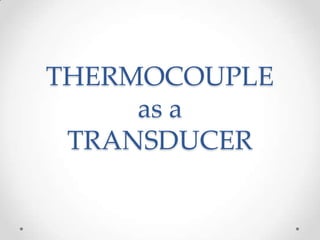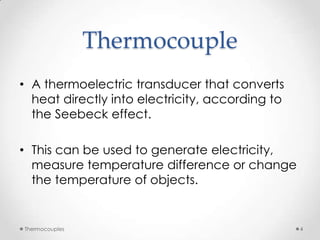Thermocouple as a Transducer
- 2. Outline Thermocouples 2 ? Introduction ? Principle ? Description ? Types ? Applications ? Advantages ? Disadvantages
- 3. Transducer variations in a physical quantity another physical quantity in measurable form Thermocouples 3 Transducers are used in instrumentation systems to interface physical quantities with analytical ones.
- 4. Thermocouple ? A thermoelectric transducer that converts heat directly into electricity, according to the Seebeck effect. ? This can be used to generate electricity, measure temperature difference or change the temperature of objects. Thermocouples 4
- 5. The Seebeck Effect temperature difference between two junctions voltage difference between them which drives the current Thermocouples 5 Eemf = - S T where, S is the Seebeck coefficient = T1 ©C T2
- 6. Basic Thermocouple Circuit Thermocouples 6 If the SA and SB are constant for the given temperature range, then From Seebeck effect, the voltage gradient at any point in the circuit, Total measured end-to-end voltage between the junctions, Vb -Vc = (SA ©C SB) (Th -Tc ) = SAB (Th -Tc )
- 7. How it looks like ? Thermocouples 7 Its construction consists of two conductors, welded together at the measuring point and insulated from each other along the length, inside an outer protection sheath.
- 8. Types of Thermocouples Type K : Chromel-Alumel Type J : Iron-Constantan Type T : Copper-Constantan Type E : Chromel-Constantan Type N : Nicros-Nisil Type S : Platinum-Rhodium Type B : Platinum-Rhodium Type R : Platinum-Rhodium Thermocouples 8 There are many thermocouples, but only 8 of them are standardized internationally. BASE METAL NOBLE METAL Each thermocouple type has a specific range of temperature and environment.
- 9. Thermocouple EMF vs Temperature Thermocouples 9 This shows that the various thermocouples differ in their respective sensitivities.
- 10. Applications ? Temperature Measurement ? Power Generation ? Radiation Sensors ? Gas Safety Equipments ? Manufacturing Industry Thermocouples 10
- 11. Advantages ? Rugged ? Inexpensive ? Quick response time ? Very simple in construction ? Used to measure temperature ranges spanning thousands of degrees, around -200 C to 2200 C Thermocouples 11
- 12. Disadvantages ? Low accuracy ? Vulnerable to corrosion ? Thermocouple operation is relatively complex with potential sources of error Thermocouples 12












